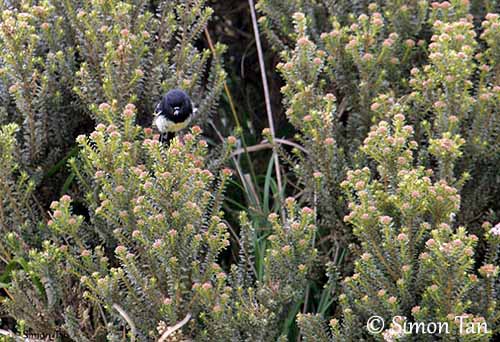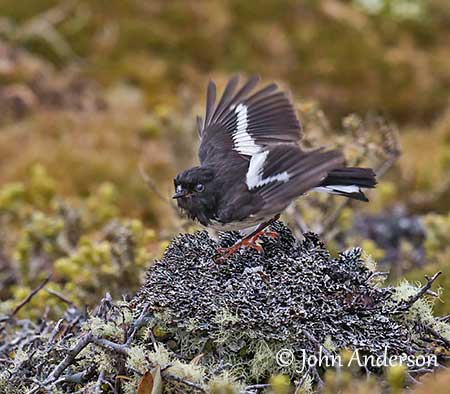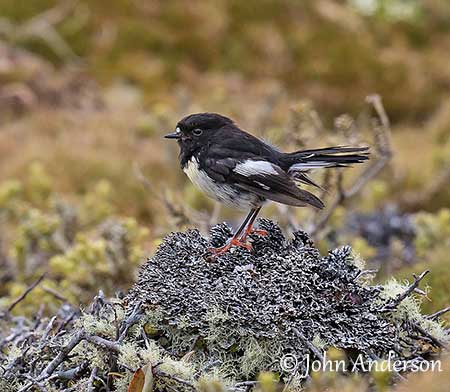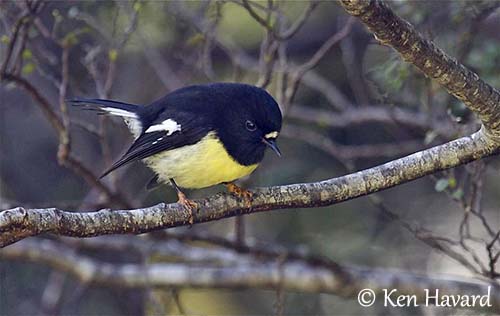
Fr: Miro mésange
All: Maorischnäpper
Esp: Petroica Carbonera
Ita: Balia della Nuova Zelanda
Nd: Maorivliegenvanger
Sd: Messydhake
Photographers:
John Anderson
John Anderson Photo Galleries
Ken Havard
My Bird Gallery & Flickr gallery 1 & Flickr gallery 2
Simon Tan
PBase Bird galleries
Text by Nicole Bouglouan
Sources:
HANDBOOK OF THE BIRDS OF THE WORLD Vol 12 by Josep del Hoyo-Andrew Elliott-David Christie - Lynx Edicions - ISBN: 8496553423
KNOW YOUR NEW ZEALAND BIRDS by Lynnette Moon - New Holland Publishers – ISBN: 1869660897
BirdLife International (BirdLife International)
New Zealand birds and birding (Narena Olliver)
Wikipedia, the free encyclopaedia
Tomtit
Petroica macrocephala
Passeriformes Order – Petroicidae Family
INTRODUCTION:
The genus Petroica is the largest of this family. These species have a prominent white or red forehead patch, and sometimes a melanistic form with all-black plumage, like the subspecies “dannefaerdi” from Snares Islands.
The family Petroicidae is that of the Australian robins.
DESCRIPTION OF THE BIRD:
Biometrics:
Length: 13 cm
Weight: 11 g
The Tomtit male of nominate race has black upperparts, head, neck, chin, throat and upper breast. Rest of underparts are pale yellow, with strong contrast against the upper breast border.
The tail is black with white patch on outer rectrices. The upperwing is black with white wingbar across the flight feathers, except the outermost primary.
On the black head, we can see a small white spot on the forehead.
The bill is black. The eyes are dark brown. The legs are black to dark brown. The feet have yellow to pinkish-brown or grey soles.

The female is similar but duller. She has dark olive-brown upperparts. Wings and tail are blackish-brown instead of black. The underparts are yellowish-white. Chin and throat are washed or mottled dark grey whereas the breast is washed olive-brown.
On the head, she has a narrow white eyering and the ear-coverts are finely streaked white.
The juvenile is duller than adults, mostly browner, with slightly mottled and streaked plumage.
SUBSPECIES AND RANGE:
P.m. toitoi is found in North I and adjacent islands in N New Zealand. This race is similar to nominate but the male has white underparts from lower breast to undertail-coverts.
P.m. macrocephala (described above and displayed) is found in South I, Stewart I and outlying islands.
P.m. dannefaerdi (displayed) occurs on Snares Islands. This race has entirely black plumage.
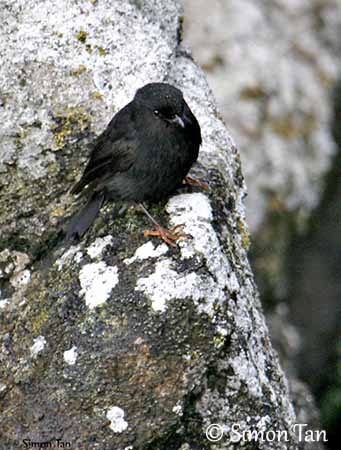
P.m. marrineri (displayed) is found on Auckland Islands. This race has yellow-white lower breast and belly, turning off-white on flanks and vent, with black tips to flank feathers. The female is browner than male, with paler underparts.
P.m. chathamensis occurs on Chatham Islands. This one is larger with black undertail-coverts. The female is warmer brown with dark face and black line above the forehead spot.
HABITAT:
The Tomtit usually lives in forests, both mature and secondary growth native forest. It also frequents Pinus plantations, and occasionally farmland, parks and gardens.
On Auckland Is, it occurs in scrub and coastal vegetation, and nearby tussock grassland and coastal rocks.
On Snares Is, it is visible in tussock grassland with scattered scrubs.
This species is scarce above 150 metres, and absent from highest elevations.
CALLS AND SONGS: SOUNDS BY XENO-CANTO
The Tomtit gives 1-5 “zet” notes when foraging alone, maybe as contact call. When disturbed, it utters 2-7 high-pitched “seee-seee” notes and some closely spaced soft whistles.
The song is a melodious warbler “ti-oly-oly-ho”, or low notes and warbling “yodi-yodi-yodi” as form of communication between pairs. They often sing while feeding.
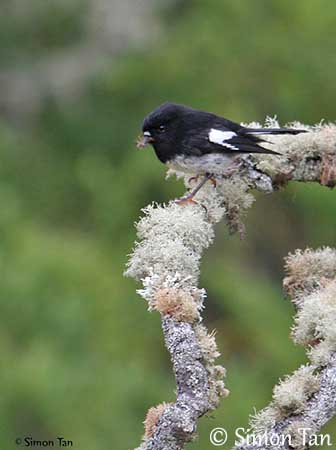
BEHAVIOUR IN THE WILD:
The Tomtit feeds mainly on insects, taking small invertebrates such as Coleopteran, caterpillars, moths, flies, spiders and earth worms too. During autumn and winter, it also consumes fruits.
It usually forages in the vegetation, perching, watching and waiting for preys. It gleans insects from leaves, branches and twigs. They feed mainly in the high canopy of the trees.
The race “dannefaerdi” from Snares Islands feeds mainly on the ground and picks preys from the surface, but it does not turn the leaves.
The Tomtits are monogamous. The pair apparently stays in the same area for life. They are territorial and defend the territory all year round. The male often chases the intruders away from the area.
During the breeding season, courtship displays are reported, with the male chasing the female with the wings held high and forwards. Another display shows male and female facing each other and flicking the wings alternately. The male also performs courtship feeding to the female.
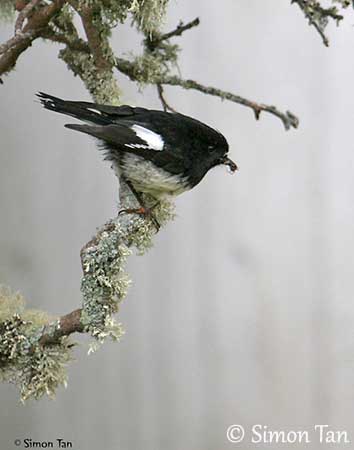
The Tomtit adult is mainly sedentary and only performs some altitudinal and short local movements. The juveniles may disperse over 16 to 50 kilometres after the nesting period.
It flies from tree to tree when feeding, performing short, rapid flights among trees, and flying down to snatch the detected prey.
REPRODUCTION OF THIS SPECIES:
The breeding season varies according to the range, Sept/Feb on North I, Sept/late Dec on South I, and Oct/Dec on offshore islands.
The Tomtit produces 2-3 broods per season.
The nest is built by the female while the male feeds her. Both mates select the site. The nest is cup-shaped. It is made with moss, leaves, rootlets, grass and bark bound together with spider webs. The inner cup is lined with finer grass, pieces of vegetation and feathers.
Such nest is placed between 1 and 4 metres above the ground, with a shelter above and on the sides. They may use a cavity or tangle of vines, or build it behind loose bark and even in nest box.
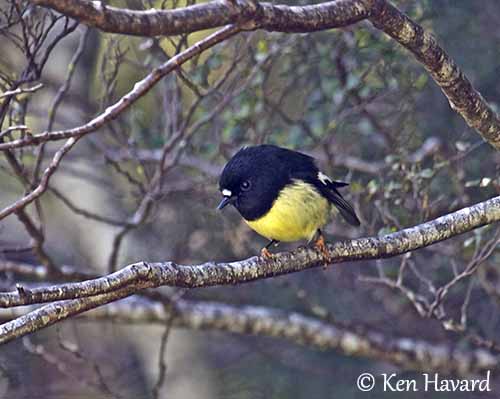
The female lays 3-4 white eggs with darker markings. The incubation, mainly by female, lasts between 15 and 20 days according to the location. The chicks are fed by both adults and the nesting period lasts 17-20 days. The young are still fed by parents for ten days after fledging.
The adults may perform distraction displays to defend the nest. The black rat (Rattus rattus) and the Long-tailed Koel sometimes attack the nests.
